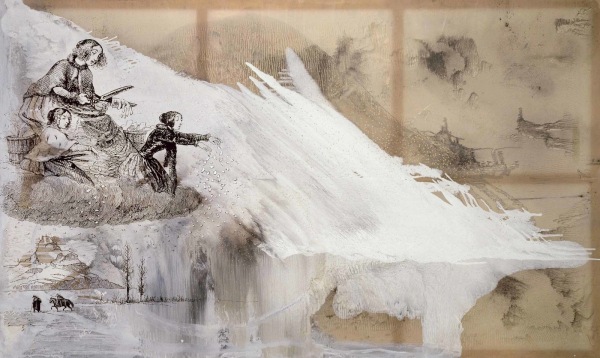Australia has never had much of a taste for German art. Apart from the epic romances of Austrian born Eugene von Guerard (1811-1901) who towered over all others during his time in Australia from 1852-1992, and produced the most magnificent landscapes unrivalled in scale and grandeur then or maybe ever, German painting has never figured much in Australian galleries or exhibitions. Nor does it feature much on Australian art school curricula although Gerhard Richter turns up here and there.

It is true that Australian art tastes have generally been conservative and provincial anyway, so perhaps it is understandable that the work of contemporary German artists is of little interest. But in America the impact of German art has been powerful over several decades and shows no decline. The Americans however seem to pick up German artists and movements just as they start fading in Germany itself .
In 2014, New York’s MOMA offered a huge retrospective of the work of Sigmar Polke (“Alibis: Sigmar Polke 1963-2010”). Polke, a contemporary of Richter, is seen as a pioneer of the formal cleverness and ironic perspective which underlies much of today’s painting. The dark irony of much of his work seems to open up a bitter playground where the gesture sits side by side with dexterous painterliness while poking fun at our aesthetic convictions. Polke was both more and less serious than Richter. Put them together and one illuminates the absences in the other.

Also unlike Richter, Polke played with everything: drawing, painting, sculpture, film, video and sound. Richter was obsessed with the visual image, the photograph in particular, and the peculiar position of painting given the existence of photography. Polke’s work is harder to assess if only because it is so much more various. And influences are far more visible: pop art, American abstraction, psychedielia, a rabid experimentalism which the far more restrained Richter eschews.

All this messing around with materials should make Polke a great favourite among contemporary artists who don’t actually want to paint. Creating abstractions on glass using old lamp soot, flinging about different kinds of paint, and attacks on the picture plane itself all have had a turn. These processes once were shocking although now they do seem fairly routine.
At times Polke seems to hover in Richterian shadows. Frau Herbst und ihre zwei Tochter (Mrs Autumn and Her Two Daughters, 1991) seems redolent of early Richter, with its base in a nineteenth century French engraving on a massive canvas where competing representations alternate across the canvas. Cheap conventional images of German guard posts in the “Watchtower” paintings reference historial trauma, almost mechanically.

No contemporary German artist can challenge the dominance of Richter, but the shame of it is that here in Australia we rarely get the chance to see any of them, let alone Richter, in a full show. My first encounter with a Richter painting in Australia was that wonderfully mysterious painting of Helga Matura with her Fiance. For me, this image is emblematic of everything Richter was trying to achieve in the 1960s. There it was, the sole Richter representative in a rather bedlamatic show, Pop to Popism a the Art Gallery of NSW, in 2014. There was a lot of fun to be had with the usual suspects, Andy Warhol, Roy Lichtenstein and Brett Whitely among them. (What? Brett Whitely as a Pop artist?) It was a good show but the inclusion of Richter as part of a Pop movement seemed very strange and his brooding, magical monochrome painting did not sit comfortably with the other male hysterics around it.

Polke responded constantly to changes in technology and their meaning for the reproduction of the image. In the late 1990s he worked on an endless series of photocopied works which occupied whole rooms of display space.

These days that generation of German artists is still influential, but maybe fading. The Leipzig school, the great Neo Rauch and his pals, also may be on the edge of exhausting their cred among the avant-garde. But if you don’t spend time in Germany and read the German art press there’s almost no way to find out. The Australian art scene is right to focus on our own, with its distinctive history and brilliant grasp of landscape, light and space. But there is a kind of underground urban sensibility which wells up now and then, and could gain a lot from exposure to German painting. I am thinking of it as opening up a counterpoint to the Australian brightness, a protected area where we can hide from all that light and insistent demand that everything be laid across vast landscapes which dwarf and minimize our presence. Australian Gothic is a recognized feature in Australian cinema. Maybe that sensibility is lurking around in painting as well.
For a really detailed discussion of Sigmar Polke, see:
http://capscrits.blogspot.com.au/2014/06/sigmar-polke-2014.html
